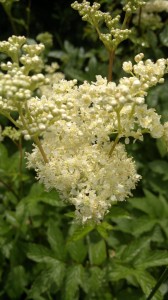Meadowsweet – Identification, distribution, edibility.
Filipindula ulmaria
- Edibility – 4/5 – Leaves, blossoms, buds and seeds. Safety note: Meadowsweet contains coumarin. In high dosage this can act as an anticoagulant, preventing blood clotting, but is generally considered safe (and widely used) in low dosage. If drying meadowsweet, ensure it is done quickly and thoroughly before storing in an airtight container, as relatively benign coumarin can be converted into the more toxic dicoumarol in the presence of some airborne moulds.
- Distribution – 4/5 – Common, especially in western Britain
- Identification – 4/5 – The creamy clouds of flowers are most distinctive, and once you learn their smell identification is easy.
- Habitat – Riverbanks, wet fields, ditches and hedgerows.
- Season – leaves April – August, blossoms June – September (later where they have been mowed and regrown)
This is the prettiest and most fragrant of all hedgerow plants, its creamy yellow clouds of tiny flowers (I call them ditch-floss) spreading honey, vanilla and almond summery scents about the countryside. Be warned though – the old english name ‘courtship and marriage’ eloquently reflects how older specimens become a little bitter! The name meadowsweet is derived from mead rather than meadow due to its historical use in brewing. I add blooms to my sloe gin to add an extra fragrant note to the liquer.
Meadowsweet is widely used in herbalism for treating gastric complaints and headaches. These traditional uses are borne out in modern medicine. Salicin – an easier to digest version of salicillic acid, was first synthesised from spiraea ulmaria – the old latin name for meadowsweet which gave its name to Asprin.
A friend who has walked the Himalayas told me that where altitude began to cause him headaches, he would always find meadowsweet. After chewing a few mouthfuls, his headache would clear. Perfect!
In this respect, meadowsweet can be both the cause of, and solution to, your hangover. It also smokes quite well if finely shredded and thoroughly dried…I’m planning a wild booze and fags walk in its honour…
In spring the young leaves can be eaten raw or cooked as a green, though many find the flavour somewhat medicinal. I used to, but since working with some very talented chefs and barmen, I have learned ways of capturing melon, vanilla (courmarin) and almond (benzaldehyde) flavours from the foliage. If you can get past the initial TCP hit, there are all manner of deep, complex and deligtful flavours to be unlocked.
Try blitzing the leaves through yogurt or creme fraiche, infusing them into mead or tinctures, or muddling them with a good gin to unlock their delights. With care, the delicate fragrance of any part can be infused into syrups, sorbets, ice creams and champagne (to make meadowsweet blossom champagne, follow the recipe for elderflower champagne here, but double or treble the quantity of blossoms as meadowsweet is more subtle), but the freshly opened flowers picked on a sunny summer day are best. They also keep their flavour on drying, though ensure this is done quickly and thoroughly for the safety reasons noted above.
Meadowsweet flowers get going just as elderflowers are on the way out. The Free Wildfood Open Air Supermarket never runs out of stock!
Read my Drinker’s Guide to Meadowsweet
Browse more plants in the Edible Wild Plant Guide
Check out the Edible Wild Fungi Guide



2 Comments
Mark do you have recipe for meadowsweet champagne or is just the same as elderflower
regards
chris
Made a dark medicinal ale with valerian, yarrow and meadowsweet as my pal used to live near a boggy meadow full of it! Was quite an interesting effect from the beer…